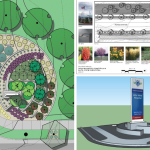 Just ask anyone here at McNeil Engineering and they will tell you. They love to build. Why? Because building construction is a complex, significant, and rewarding process. It begins with an idea and culminates in a structure that may serve its occupants for several decades, even centuries. Engineers and construction professionals build structures to stand the test of time.
Just ask anyone here at McNeil Engineering and they will tell you. They love to build. Why? Because building construction is a complex, significant, and rewarding process. It begins with an idea and culminates in a structure that may serve its occupants for several decades, even centuries. Engineers and construction professionals build structures to stand the test of time.
Like the manufacturing of products, building construction requires an ordered and planned assembly of materials. It is, however, far more complicated than product manufacturing. Buildings are assembled outdoors by many diverse constructors and artisans on all types of sites and are subject to all kinds of weather.
It’s important to note that even small or modest-sized buildings must satisfy many performance criteria and legal constraints. They must meet many local regulations and they require an immense variety of materials. They also involve a large network of design and production firms. Still, these jobs are not easy. Building construction is further complicated by the fact that no two buildings are identical. That’s right. Each one must be custom-built to serve a unique function and respond to its specific context and the preferences of its owner, user and occupant.
Evaluating a building’s unique properties
Because of a building’s uniqueness, there are basic construction principles every building and engineering firm must follow. They do not have to reinvent the wheel. They are merely refining and improving the building delivery process. In so doing, they bring to the task the collective wisdom of the architects, engineers and contractors who have done so long before they did.
Sure, there are building procedures that promote the development of standardized, mass-produced buildings, but these seldom meet the distinct needs of each user. Unique buildings have unique needs and must meet the needs of unique users.
Still, regardless of the uniqueness of each building project, the flow of activities, events and processes necessary for a project’s realization is virtually the same in all buildings. There are standardized procedures that construction and engineering professionals must follow to ensure the job gets done right.
That’s why we wanted to take a quick look at the overview of the workflow that brings about a building—from the inception of an idea or a concept in the owner’s mind to the completed design by the architects and engineers and, finally, to the actual construction of the building by the contractor.
The difference between construction and design
Design and construction are two independent but related and generally sequential functions in the construction of a building. The former function deals with the creation of the documents, and the latter function involves interpreting and transforming these documents into reality—a building or several structures.
The discussion starts with the various personnel involved in a project and the relational framework among them. Subsequently, a description of the two major elements of design documentation— construction drawings and specifications —is required for every project. What are some of the methods used for bringing a building into being, referred to as the project delivery methods? From the owner’s perspective, these methods are called project acquisition methods.
What are the project delivery phases that go into a project? The process by which a building project is delivered to its owner may be divided into the following five phases, referred to as the project delivery phases. Although there is usually some overlap between adjacent phases, they generally include a pre-design phase, design phase, preconstruction phase, construction phase, and postconstruction phase.
In Utah and beyond, buildings are a necessity
When you think of the things you need to survive, what comes to mind? Food and water probably top your list. Clothing probably isn’t far behind. There’s one other basic need that we sometimes take for granted: shelter. If you don’t have a safe place to sleep at night, life can become very difficult in a hurry. Think of the struggle the homeless of the world experience nightly. Most of us are fortunate enough to have a roof over our heads.
The buildings we live in come in an almost endless variety of types, shapes and sizes. Some houses are small, some are large. Some houses are mobile. Others might be skyscrapers that contain thousands of apartments. When it comes to buildings, the number of different types of structures that exist around the world is mind-boggling. From grass huts in the tropics and igloos in the Arctic to skyscrapers in the big city and single-family homes in the suburbs, it seems like there’s a building to suit every environment and purpose.
And that’s where McNeil Engineering comes in. We have been working on buildings, structures, bridges, roads, highways, and landscapes for many decades. When it comes to completing your engineering job on time and under budget, turn to your friends at McNeil Engineering.








